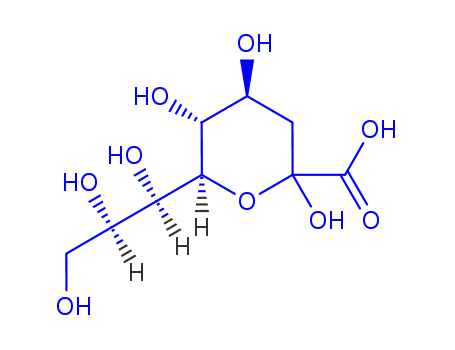10.1248/cpb.43.1844
The research focuses on the synthesis of fluorescent 4-methyl-7-thiocoumaryl S-glycosides of sialic acid, which serve as fluorogenic substrates for tracing and quantifying sialidase activity in biological systems. The purpose of this study is to develop new tools for investigating the biological functions of sialic acid in glycoconjugates on bacterial and viral outer membranes. The researchers successfully synthesized three new fluorogenic substrates: 4-methylcoumarin-7-yl S-glycosides of N-acetylneuraminic acid, N-glycolylneuraminic acid, and 3-deoxy-D-glucose-D-galacto-2-nonulopyranosonic acid (KDN). They also developed a method for the preparation of a key intermediate, benzyl 5-amino-3,5-dideoxy-D-glycero-D-galacto-2-nonulopyranosidonic acid (7), which is crucial for the synthesis of N-glycolylneuraminic acid. The synthesis involved various chemicals, including 4-methyl-7-thiocoumarin sodium salt, methyl 5-N-acetyl-4,7,8,9-tetra-O-acetyl-2-chloro-2,3,5-trideoxy-D-glycero-D-galacto-2-nonulopyranosonate, and other related compounds, with the process utilizing Williamson reaction conditions and deprotection steps to yield the final products. The structures of the synthesized materials were confirmed using proton nuclear magnetic resonance (1H-NMR) and carbon-13 nuclear magnetic resonance (13C-NMR) spectroscopy.
10.1016/S0040-4020(01)97593-3
This study explores the use of N-acetylneuraminate pyruvate lyase (sialyl aldolase) in organic synthesis. The study demonstrates that sialyl aldolase can catalyze the condensation of pyruvate with various non-nitrogenous sugars, such as D-mannose, to produce ulosonic acids like 3-deoxy-D-glycero-D-galacto-2-nonulosonic acid (KDN). The enzyme shows a broad specificity, accepting substrates with different substituents at C(2) provided the D-manno configuration is retained. The authors successfully synthesized several ulosonic acids using immobilized lyase, achieving good yields and demonstrating the potential for scaling up the process. They also explored the enzyme's tolerance to various modifications at different positions of the sugar molecule, revealing its preference for certain configurations and the challenges in using D-arabinose as a substrate.





